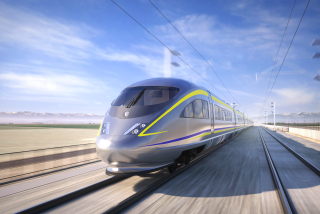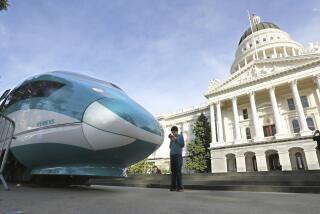National Park at Train Yard Is Focus of Debate : History: Plans for a railroad museum are derided as pork-barrel politics. Supporters insist the spot is historically significant.
SCRANTON, Pa. — Steamtown, its detractors say, is on the wrong track.
This national-park-in-the-making--a place where weeds dried in the winter sun sprout next to passenger cars at least 20 years removed from their latest paint job--lacks historical significance, they say.
They dismiss plans for a railroad museum as pork-barrel politics at its worst.
John Latschar ignores the naysayers. Latschar is superintendent of Steamtown, and he firmly believes if he can construct a working monument to the railroads. If he builds it, they will come, he insists.
“They’re going to be able to go into the roundhouse and see our mechanics keep our locomotives running,” he said. “It’s huge machines and puny men. There’s no other place in the world where they can do that.”
But Congress voted last week to cap and restrict spending for Steamtown, and Steamtown may never become the railroad mecca envisioned by Latschar.
There are 13 buildings on Steamtown’s 41-acre site, itself an abandoned yard of the Delaware, Lackawanna and Western Railroad.
Each was built between 1865 and 1937 and each listed on the National Register of Historic Places. All will be converted to use in the park; an oil house will become a bookstore, for example.
Ramps in the restored roundhouse bring visitors within 20 feet of open maintenance areas. Messier boiler work is done farther away but within view.
“Our visitors ought not to wear their Sunday best when they come calling; they’re liable to go home a little soiled,” said Ed Rogers, a member of Steamtown’s board and managing editor of The Scranton Times and The Tribune newspapers. “Steamtown is designed that way.”
Steamtown has collected 30 locomotives. For now, excursions run to Kingsley, most of the way to Binghamton, N.Y., and to Moscow, Pa., on the way to Delaware Water Gap via the Pocono Mountains.
“We don’t just call ourselves a train ride,” said Latschar’s assistant, Calvin Hite. “That’s a part of it, but we’re an interpretive center.”
Originally, Steamtown was a private enterprise. But then the developers ran out of cash, and the project--which was regarded as an economic godsend for perennially distressed Northeastern Pennsylvania--was left in the lurch.
In 1986, Rep. Joe McDade (R-Pa.), had secured initial approval for the National Park Service to lend technical assistance to the developers. And the project fell into the park service’s lap when the developers failed in 1987.
“The state didn’t want to do it, the city was broke and all of a sudden we’re in the railroad business,” Hite said.
McDade, a 15-term member of Congress from Scranton, is proud of Steamtown. “We’ve got the sound, the smell, the feeling of the railroad,” he said. Steamtown, he said, “fits every definition of a national park.”
But the former curator for transportation of the Smithsonian Institution, John White, wrote in American Heritage and Invention and Technology that Steamtown was “a third-rate collection.”
He and other critics note that there are eight Canadian engines among Steamtown’s trains, that none are from the 19th Century, and that only one is linked to Scranton.
“It would seem there are a lot of other museums that have a better collection of locomotives,” said Don Snoddy, curator of the Union Pacific Historical Museum in Omaha, Neb.
Critics also say Scranton has little relevance to American railroading. They say the government should fund instead Baltimore’s popular B&O; Railroad Museum or the county-operated National Museum of Transport in St. Louis, though neither offers excursions.
The National Museum is on a siding from the original railroad route west. The B&O;’s is on the site of the first train station in the country.
“Scranton isn’t all that far from Baltimore,” said Snoddy, from the Union Pacific. “If the point of a museum is to have one every 200 miles, then you ought to have one in Seattle, Las Vegas, New Orleans and Miami.”
These arguments have had their effect in Congress.
Rep. Joel Hefley (R-Colo.) called Steamtown the “god-darnedest boondoggle joke you ever saw,” and in November the House National Parks and Public Land subcommittee, capped spending on the project at $53 million.
McDade raised the issue again in the new congressional session. In a last-minute compromise between McDade and parks subcommittee chairman Bruce Vento, D-Minn., the House Committee on Interior and Insular Affairs voted Wednesday to cap development spending for Steamtown at $66 million.
That is just a few million less than the $73 million McDade had sought. But other constraints in the Vento legislation will be more of a problem for the park’s operations than the funding level.
Among other things, the bill forbids spending any money to repair track or bridges outside the park, limits the number of working steam engines to three, and kills plans for a pedestrian bridge to a new mall that is to spread across a large plot of land in downtown Scranton.
Steamtown’s supporters insist that the spot is historically significant--it was created in the mid-1800s to deliver rails for Lackawanna Iron & Coal, one of the nation’s largest producers of rails. Five hundred locomotives were built next door at the Dickson Locomotive Works.
And Latschar is convinced that he can rekindle the spirit of railroads here--given the chance. And if he can persuade his opponents to come to Scranton, to see the place where he hopes to help visitors “smell the smoke and hear the sound of valves clapping,” he knows he will be given the chance.
“If we can get people on site, it’s easy to get them walking away, nodding their heads, going ‘Yeah. This is where it should be,’ ” Latschar said.
More to Read
Sign up for Essential California
The most important California stories and recommendations in your inbox every morning.
You may occasionally receive promotional content from the Los Angeles Times.










